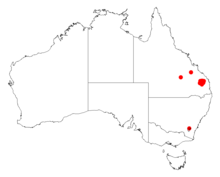| Acacia grandifolia | |
|---|---|
| Scientific classification | |
| Kingdom: | Plantae |
| Clade: | Tracheophytes |
| Clade: | Angiosperms |
| Clade: | Eudicots |
| Clade: | Rosids |
| Order: | Fabales |
| Family: | Fabaceae |
| Subfamily: | Caesalpinioideae |
| Clade: | Mimosoid clade |
| Genus: | Acacia |
| Species: | A. grandifolia
|
| Binomial name | |
| Acacia grandifolia | |

| |
| Occurrence data from AVH | |
Acacia grandifolia is a tree belonging to the genus Acacia and the subgenus Juliflorae that is native to north eastern Australia. It is list as vulnerable according to the Environment Protection and Biodiversity Conservation Act 1999.[1]
Description[edit]
The tree typically grows to a maximum height of 8 m (26 ft). It has dark brown coloured bark that is deeply furrowed. The acutely angular and stout branchlets are densely covered in soft velvety grey hairs. Like most species of Acacia it has phyllodes rather than true leaves. The evergreen asymmetrically elliptic phyllodes are more or less straight with a length of 7.5 to 15 cm (3.0 to 5.9 in) and a width of 20 to 50 mm (0.79 to 1.97 in). The phyllodes are stiff and coriaceous and have three to four yellowish and prominent main nerves running together near the base. It blooms between July and October[1] producing golden flowers.[2] It produces cylindrical flower-spikes with a length of 4 to 9.5 cm (1.6 to 3.7 in) followed by seed pods that are constricted between and raised over the seeds The densely haired seed pods have a length of 6 to 8 cm (2.4 to 3.1 in) and a width of 5 to 6 mm (0.20 to 0.24 in) with longitudinally arranged seeds inside.[2]
Distribution[edit]
It is endemic to two small areas in the Burnett District of south east Queensland where it is often situated amongst outcrops of sandstone growing in sandy or in shallow, stony soils that have originated from basalt.[2] It is found in hilly terrain of differing slopes and aspects, in gullies, on plains and on hill crests. and grows well in disturbed ground and along roadsides.[1] It occurs in dense stands or as part of gun-tree woodland communities along with Eucalyptus crebra, Corymbia citriodora, Corymbia trachyphloia and Eucalyptus exserta.[1]
See also[edit]
References[edit]
- ^ a b c d "Acacia grandifolia". Species Profile and Threats Database. Department of the Environment and Energy. Retrieved 20 October 2019.
- ^ a b c "Acacia grandifolia Pedley". Wattle - Acacia of Australia. Lucid Central. Retrieved 20 October 2019.
